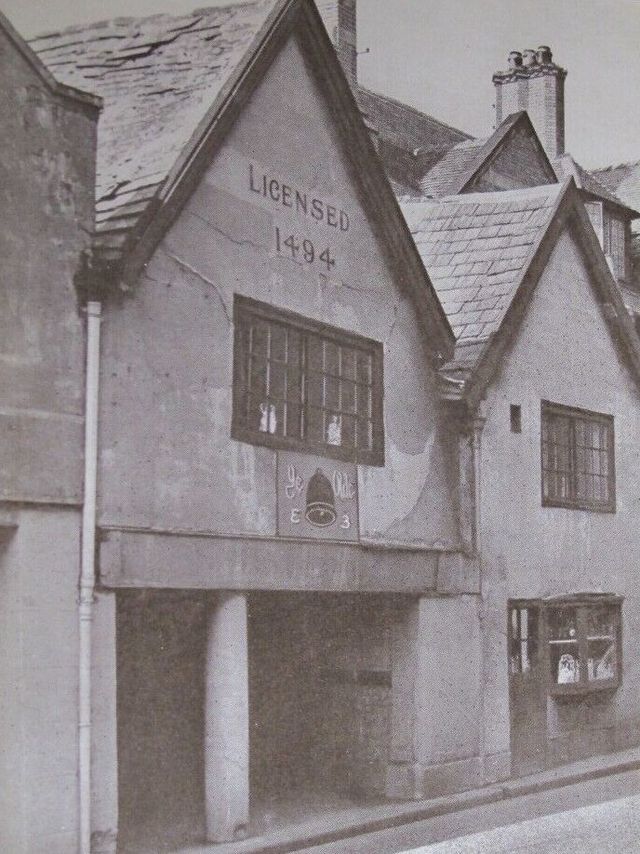» Main Index

» Search This Site

» Submit Update

» Contact Us


|
|

|
Home > Cheshire >
Chester > Blue Bell
Blue Bell
 |
|
|
|
|
|
|
The Blue Bell was situated at 63-65
Northgate. This grade-I listed pub is
now in use as a restaurant. |
|
|
|
Originally it consisted of two medieval houses
which were joined together in the 18th century. The pavement runs through
the ground floor storey of the northern part of the building, leaving a
separate cabin or chamber between the pavement and the road. |
|
The building dates from the mid- to
late 15th century, and is said to be the oldest surviving intact medieval
house in Chester. It was originally two houses, which were joined in the
18th century. It formed part of Lorimer's Row, a group of buildings with an
arcade at ground level, as distinct from the Rows in the centre of the city
whose walkways are at the first floor level.[1][3] From an early date, the
south part of the building has been an inn, its first licence possibly
dating from 1494. The separate cabin or chamber has been used for a number
of functions; these include being a ticket office for stage coach operators
in the 18th century and in the 20th century a soda fountain bar and a
barber's shop. In the 19th century the southern part of the building was an
inn while the northern part housed a shop.[1] The inn closed in the 1930s.
In 1948 the building was used as an antique shop but its condition
deteriorated so much that it was threatened with demolition. In the 1950s
the Chester Civic Trust campaigned for its survival, it was restored, and
has since been used as a clothes shop and, more recently, as a restaurant. |
|
|
|
|
|
|
Listed
building details: |
|
2 shops and town houses; mid to late
C15; No.63 was for long the Blue Bell Public House and since the early C19
No.65 was a shop; the tenements are now joined as a restaurant. Timber
frames, sandstone and later brickwork, the front now rendered and the side
painted; grey slate roofs. EXTERIOR: 2 storeys, plus cellars. The frames of
the 2 houses are separate, under parallel roofs with ridges at right angles
to the street; the narrow space between is now occupied by stairs and
lobbies joining the buildings. 2 gables to front. No.63 has open front to
the street, a painted brick pier to south and an octagonal painted stone
column south of centre with a plain stone cap; No.65 has a stall enclosed as
a booth between the street and the covered pavement walkway, rendered to
front and sides, with a small canted 3-pane oriel to the street and brick
with large framing and a boarded door to the pavement. The face to the rear
of the pavement is largely painted brick with a framed 2-board door to No.63
and a 4-board door to No.65; a replaced window of 16 panes with 4-panel
shutters to No.63, a small 1-pane window at centre and a 4-pane sash with
6-panel shutter to No.65. A replaced window of horizontal proportions in the
gable to No.63. Two valley chimneys, a chimney on the ridge of No.65, one at
the south-west corner of No.63 and a single-flue chimney at the north-east
corner of the front booth to No.65. The north side of painted brick has
replaced horizontally-sliding sashes to the first storey, and to the second
storey a 4-pane casement and a flush 9-pane sash in a half-dormer. INTERIOR:
the features of greatest interest are in No.63. The cellar across the front
has coursed rubble sandstone walls, stone steps from rear in No.63 and
timber ceiling structure; No.63 has a later barrel-vaulted rear cellar. The
side walls of the first and second storeys were studded; some posts and
studs are exposed, and some chamfered beams and oak joists to the first
storey. Some large framing to both storeys of the front wall is visible. The
north-east corner post in No.63 has a later console. The broad fireplace in
the north side of No.63 has a sandstone back, old brick cheeks and an oak
bressumer. The late C17 newel stair has barleysugar turned balusters to the
first 3 steps and to the landing; a 3-board oak door near the stair-head has
2 planted panels on its outer face and battens on its inner face; painted
stone mantelpiece to blocked south-west corner fireplace. The adjacent roof
structures at eaves level, with rafter-ends of the roof of No.65, and the
former gap between the 2 houses are exposed near the rear of No.63, and less
clearly near the front. The wall-plates are visible; the gable tie-beams,
curiously, are also jointed to the corner-posts like wallplates. No.63 has 2
truss-posts on each side. The first internal truss, formerly the central
truss of the solar, has a shaped octagonal crown-post braced from the
cambered tie-beam and to the principal rafters and the crown-purlin; the
truss at the back of the former solar is undecorated, with square post
braced from the cambered tie-beam and to the crown purlin; the third
internal truss, formerly between chamber and hall, is similar but with
tie-beam less cambered. The trusses over No.65, less visible, are
undecorated. This property includes the best example, other than in the
Rows, of a medieval town house in Chester. (Harris R: Chester Rows Research
Project: 1989-). |
|
|
|
Do you have any anecdotes, historical information, updates or photos of this pub? Become a contributor by submitting them here. Like this site? Follow us on

You can also make email contact with other ex-customers and landlords of this pub by adding your details to this page. |
|
|